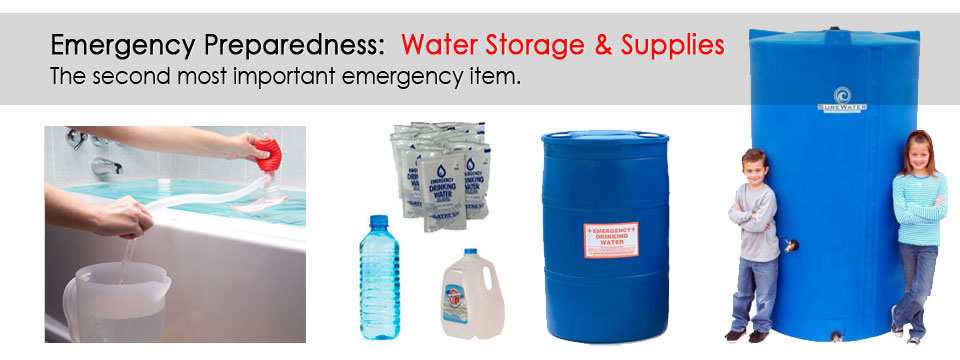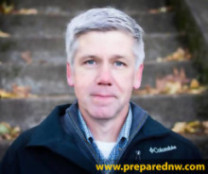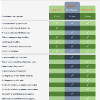Let’s say that your city’s water supply system is damaged badly due to a very large and violent earthquake.
Water mains are broken, the reservoirs are draining, the electricity is out and the water purification plant is damaged beyond repair. Now let’s say that officials warn that it could be 30 days before consistent potable water is available to the public. They also warn that raw sewage will flow freely from all upstream cities into the rivers and should not be used for drinking. Are you getting thirsty yet? These events are very likely should there be a significant earthquake (for which we are overdue) in Oregon, Washington, Idaho or even Northern California.
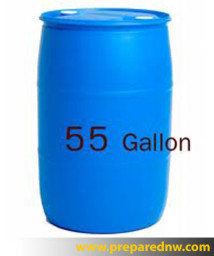 So the first question is, how much water do I really need?
So the first question is, how much water do I really need?
A rule of thumb would be 2 gallons of potable (drinkable) water and 3 gallons of non-potable water per person. Potable water is used for drinking, cooking, brushing teeth, washing dishes and bathing. Non-potable water is used for flushing toilets but can also be used for washing clothes and bathing. If the emergency lasts for 30 days and you have a family of 4, that’s 600 gallons. It’s wise to maintain a permanent stockpile of 100 gallons at a minimum. It’s possible that your area’s water reservoirs are not depleted yet so there might be some water available in your taps.
NOW is the time to fill everything you own with drinking water.
Grab garbage cans, dirty or not and line them with new plastic leaf bags and fill them up. You can also use rain or standard water barrels. Do you have rain barrels?Each rain barrel holds around 50 gallons of water and can be used as potable water if filtered and chlorinated. It can also be used for non-potable tasks I mention above. A great place to find plastic barrels is Craigslist.com. These can be used as rain barrels or part of your permanent water storage plan. Make a thorough barrel inspection before purchasing and make sure the barrels are either brand new or they only held food grade products. Used barrels need to be completely washed out and sanitized with bleach before using. After purchase, add a water preserver to the barrels while filling to extend the water’s freshness and increase the storage time. Make sure the barrel has tight-fitting caps before leaving the seller’s property. These are hard to find after the fact.
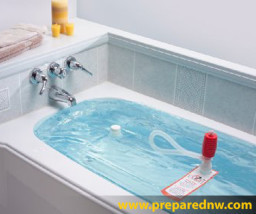 An item everyone should own is called “the WaterBOB”.
An item everyone should own is called “the WaterBOB”.
This is a plastic bag that’s designed to fit in the bathtub and fill from the faucet. It holds 100 gallons and comes with a hand pump for easy water removal.
Do you know a neighbor that has a swimming pool?
Pool water should only be used as non-potable for flushing the toilet. It might be a good idea to discuss this with your neighbor before the natural disaster or you might not have access to it.
There are many options today for purifying questionable water.
Filter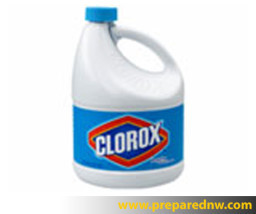 ing is very common and many people use this method regularly in Brita water pitchers. Other methods include boiling, chemical disinfection, distillation, reverse osmosis and UV light. The big concern when using any method is making sure all the pathogens are killed or removed. These pathogens include bacteria, protozoa, fungi, parasitic worms and viruses. A great disinfectant that you find in most homes is bleach. Be sure it is the unscented type without perfumes and additives. Fill a sealable 1-gallon container with the questionable water and add 15 drops of bleach and shake it up. Let the container sit for 30 minutes. Remove the cap and smell the water. If you smell bleach, then the water is safe to drink. If no bleach smell, add another 15 drops and repeat the process. If you don’t smell the bleach this time, then this water source is bad and should only be used for the toilet. Use your best judgment when picking water sources. If it looks cloudy, stagnant or stinks avoid it. One final note: Never underestimate the importance of clean drinking water.
ing is very common and many people use this method regularly in Brita water pitchers. Other methods include boiling, chemical disinfection, distillation, reverse osmosis and UV light. The big concern when using any method is making sure all the pathogens are killed or removed. These pathogens include bacteria, protozoa, fungi, parasitic worms and viruses. A great disinfectant that you find in most homes is bleach. Be sure it is the unscented type without perfumes and additives. Fill a sealable 1-gallon container with the questionable water and add 15 drops of bleach and shake it up. Let the container sit for 30 minutes. Remove the cap and smell the water. If you smell bleach, then the water is safe to drink. If no bleach smell, add another 15 drops and repeat the process. If you don’t smell the bleach this time, then this water source is bad and should only be used for the toilet. Use your best judgment when picking water sources. If it looks cloudy, stagnant or stinks avoid it. One final note: Never underestimate the importance of clean drinking water.
Having a plan and preparing in advance can turn an unbearable situation into a comfortable inconvenience. Being prepared is being responsible.
Do you have a question about Emergency Preparedness?
Please comment below or contact us at 503-757-7572 or email preparednw@gmail.com.
![]() Prepared Northwest offers families in Oregon and Washington consultations and customized emergency preparedness plans that fit their needs and budget. Contact us today for a free initial consultation.
Prepared Northwest offers families in Oregon and Washington consultations and customized emergency preparedness plans that fit their needs and budget. Contact us today for a free initial consultation.

